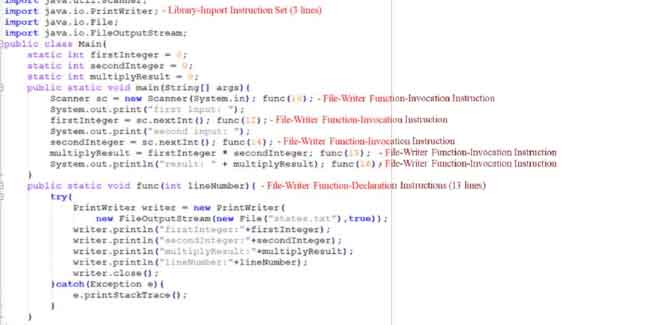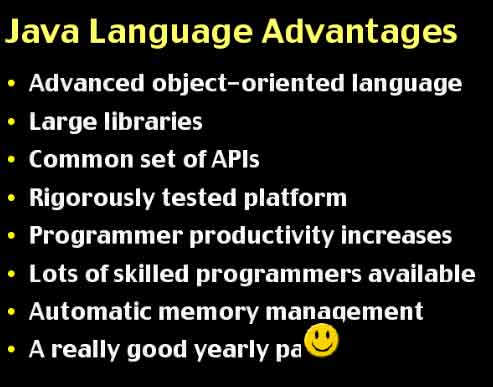Java is a high-level, general-purpose computer programming language and a computing platform developed by Sun Microsystems in 1995. It is similar to C and C++ but a lot easier. It permissions the programmers to write computer programs in the English language instead to write the program in numeric codes. It is famous as a high-level programming language because it is read and written easily by human-beings.

It is a fast, secure, reliable, robust, concurrent, class-based, and object-oriented programming language. It works on the principle of WORA (Write Once, Run Anywhere). It is free for everyone and platform-independent so that it can be run on different platforms, like Windows, Mac OS, and the different versions of UNIX.
It can be combined with other technologies like Android, Hadoop, Spring, Node.js, J2EE, etc. to develop robust, portable, scalable, and distributed full-fledge applications.
Take coaching in the Best Java Training Institute In Laxmi Nagar to learn how to combine Java to other technologies to create Apps like these.
It has a set of rules that determines how to write an instruction. These rules are called syntax. Once a program is written, the high-level instructions (written in human-understandable language) are converted into numeric codes that the computer understands and executes.
Platform: It is a combination of hardware and software environments in which a program runs. Java has a runtime environment (JRE) and API.
Example of a Java Program
public class Classname
{public static void main(String[] args)
{System.out.println(“Hey!”);}

For more knowledge of Java programming, have a look on google for Java Training Institutes near me to find Best Java Training Institute in Laxmi Nagar
Architecture – The Java Environment
- There is a process of Compilation and Interpretation in Java
- The code written in a high-level language is converted into numeric codes through the Java Compiler.
- The numeric codes are converted into machine code by the JVM.
- The machine directly executes the converted machine code.
Components of Java Architecture
JVM, JRE, and JDK are the three main components of the Java programming language.
JVM – Java Virtual Machine
JRE – Java Runtime Environment
JDK – Java Development Kit
JVM – Java Virtual Machine
Java works on the principal WORA (Write Once, Run Anywhere). It is known as WORA because it has the ability to run code on any platform. It is platform-independent because of JVM.

The JVM is a component of the Java platform that provides an environment where programs are executed. JVM converts numeric code into machine code; then machine executes the machine code in which the Java program runs.
JVM performs the following main functions:
- Loads the source-code
- Verifies the source-code
- Executes the source-code
- Provides runtime environment
JVM Architecture:
ClassLoader:
It works as a subsystem of JVM. It loads class files whenever a Java program executed.
Java has three built-in classloaders:
- Bootstrap Classloader
- ExtentionClassloader
- System/Application Classloader
To learn about Java built-in Classloaders search on google java classes near me
Class Method Area:
It is the Data Area in JVM, in which Class data stores. Static Variables, Static Methods, Static Blocks, Instance Methods are also stored in this area.
Heap:
When JVM starts up, a heap creates. Its size can increase or decrease as application runs. It is a memory section that contains objects and reference variables. In the heap, Instance variables also create. Data is allocated at runtime in the heap.
Stack:
JVM stack is also called a thread stack. It works as a data area in the JVM memory, which creates a single execution thread. The JVM stack is also used to store different types of elements like local variables, partial results, methods, reference variables, and data for the calling method and returns. It is always referenced in a Last-In-First-Out manner.
Native Stack:
It consists of all the native methods used in the application.
Execution Engine:
- JIT Compiler
- Garbage Collector
Go to your nearest Java Institute or search on Google for Java Institute Near Me to learn about the Execution Engine.
JIT (Just-In-Time)Compiler:
It is a part of the runtime environment. It helps to improve the performance of Java applications by converting numeric code into machine code at run time. By default, it is enabled. Whenever a method is compiled, the JVM calls the compiled code of that method, and the JIT compiler converts the numeric code of that method into machine code, compiling it “just-in-time” to run.
Garbage Collector:
It is used to collect the unused material. It tracks each object available in the Heap space and removes unwanted objects.
It works in two easy steps:
- Mark: It is the place where the Garbage Collector identifies which part of memory is in use and which is not.
- Sweep: It removes unwanted objects identified in the “Mark” phase.
Native Interface:
It is a framework that works as an interface to establish communication with another application in a programming language like C, C++, etc.
JRE – Java Runtime Environment
It is a software that creates a runtime environment in which Java programs can be executed. It is an on-disk system that takes your Java code, connects it to the required libraries, and starts the JVM to execute the Java program.
It contains libraries and software which are essential to execute your Java program to run.
JDK – Java Development Kit
It is a software development environment that is used to develop and execute Java applications and applets. It contains JRE, development tools, and other resources like the loader/interpreter (Java), an archiver (jar), the compiler (Javac), and a documentation generator (Javadoc) accompanied by another tool.

The blue area in the diagram is representing the JDK – Java Development Kit.
Java: It is a launcher for all Java applications.
Javac:It is a compiler of the Java programming language.
Javadoc:It is a documentation generator API.
Jar:It creates and manages all the JAR files.
To learn how to combine Java with other technologies, have a look on Google for C C++ Java Classes Near Me to grab a perfect knowledge about Java.
Features of Java Programming Language

Platform-Independent
Java was built on the principle of WORA (Write Once, Run Anywhere). The Java program is written on a platform (operating system) will run on other platforms (operating systems) without any modification.
To run Java, JVM (Java Virtual Machine) is used. The JVM executes the Java numeric code. After that, the CPU executes the JVM.
As all the JVM works precisely the same, the same Java program works on the other platforms (operating systems) as well, which makes Java platform-independent.
Object-Oriented
There are different types of programming approaches in Computer Science. The object-oriented approach is one of the best programming approaches. In the object-oriented approach, a sophisticated program is divided into smaller sets by creating objects. This makes Java program reusable, have design profits, and makes the program easier to handle or maintain.
Java mostly focuses on objects compared to processes.
Java follows the principles of Object-Oriented Programming (OOP) Approach:
– Objects
– Classes
– Inheritance
– Encapsulation/Data Hiding
– Abstraction
– Polymorphism
To learn more about OOPs, get information on Google related to Java Classes Near Me for a better place to gather knowledge about Java.
Note: Java is not a wholly pure object-oriented programming language, as primitive data types can be created.
Portable
Java is written in ANSI C with a portability boundary, which is a subset of POSIX. It is portable because a Java program can be executed on all platforms. As a Java program is compiled to numeric code, those compiled numeric code files can be used on any Java-Supported platforms without doing any modifications in it compared to other languages, which requires to compile the machine code for every platform. E.g., a separate .exe file for a 32-bit or 64-bit environment. The main reason for being Java portable is that a Java numeric code file can be carried over to any other platform where it runs on.
Secured
Java platform provides different types of features to secure Java applications. High-level features that Java handles are:
i). Lack of pointers makes Java powerful and secure.
ii). Secure platform for running and developing applications.
iii). Automation of memory management, which reduces memory corruption and vulnerabilities.
iv). Secure communication by protecting the integrity and privacy of data transmission.
v). Java programs run inside a virtual machine sandbox.
vi). The JRE (Java Runtime Environment) contains a Classloader to load classes into the JVM (Java Virtual Machine dynamically. It separates the packages for classes of the local file system imported from the networks.
vii). The numeric code verifier checks fragments of code for the defected code that can bypass access into the system.
viii). Security Manager decides what resources have to allot to a class. Such success can be reading and writing the files.
Java can help to build a virus-free system.
Search for Java classes near me and take classes to know about how to secure a Java application?
Robust
Robust means strong. The following features make Java powerful and straightforward:
i). There is a lack of explicit pointers that prohibits security problems.
ii). Have strong and powerful memory management.
iii). Automatic garbage collection runs in the JVM (Java Virtual Machine) to get rid of unreferenced objects manually, which are no longer usable in a Java application anymore.
iv). There are type-checking and Exceptional Handling mechanisms that make Java robust.
Large Standard Library

Java is widely used because it has the availability of a substantial standard library. Java has hundreds of classes and ways under different types of packages to make it easy for developers to build applications.
Example:
java.util – for regular expressions, date and time functions, data structures, etc.
java.io – for the file I/O, exception handling, etc.
java.lang – for arrays, advanced features of string, etc.
Go to Google and search for Java Courses near me to enroll in a Java course to know about different types of standard libraries and their functions.
Reliability
Java was created to reduce fatal errors done by programmers in their coding. With keep an eye on it, the object-oriented-programming approach was introduced. In Java, data and its manipulation were packaged together in a single place.
Simple
Java is straightforward to learn because its syntaxes are simple, clean, and easy to understand. Java programming language is a simple programming language because of these reasons:
i). Java syntaxes are based on C++; it becomes easier for programmers to learn it quickly if they have a good knowledge of C++).
ii). Many complicated and rarely-used features are removed in Java. E.g., operator overloading, explicit pointers, etc.
iii). No need to remove unreferenced objects because, in Java, Automatic Garbage Collector is available.
Have a look on Google related to java classes near me to find the Best Java Training Institute in Laxmi Nagar
Fast
Earlier versions of Java were not too famous for being slow. The new JVMs (Java Virtual Machines) are faster than before. And the CPU that executes JVM is also becoming more and more robust and powerful.
Nowadays, Java is one of the famous and fastest programming languages. Optimized Java is swift as the lower-level languages like C/C++ and quicker than Python, PHP, etc
Architecture-Neutral
Java is an architecture-neutral programming language because implementation-dependent features are not available. E.g., the size of primitive types is fixed.
In the C programming language, int data type contains 2 bytes of memory for 32-bit hardware architecture and 4 bytes of memory for 64-bit architecture. However, it contains 4 bytes of memory for both 32-bit and 64-bit hardware architecture.
Have a look on any search engine related to Java Classes Near Me to find the best Java Training.
The latest version of Java is Java SE 8. Advancement of Java and its popularity, multiple configurations were done to support various types of platforms. E.g., J2ME for Mobile Applications, J2EE for Enterprise Applications.
New J2 versions were renamed as Java EE, Jave SE, and Java ME, respectively.
High Performance
Use of Just-In-Time compilers, Java enables high performance for a program. Java is faster than other interpreted programming languages because the Java numeric code is very close to native code. It is also a little bit slower than compiled languages like C++. Java is an interpreted programming language that is why it is slower than compiled programming languages like C, C++, etc.
Find out the python course in Delhi to learn python Programming Language efficiently.
Interpreted
Java numeric code is translated into native machine instructions, and those machine instructions are not stored anywhere. The development process of Java is more rapid and analytical since the linking is an incremental and light-weight process.
Multithreaded
A thread is a separate program, executing simultaneously. This design allows developers to build interactive applications that can run smoothly. A Java program can be written as that deal with many tasks at once time by defining multiple threads in a Java program. The main advantage of multi-thread is that it does not occupy memory for any thread. It shares a common memory area for everything. Threads are so much important for Web applications, multimedia, etc.
Distributed
Java is distributed as it allows users to create distributed applications. EJB & RMI are used while creating a distributed application. This superb feature of Java can access files by calling the methods from any machine on the internet.
Go to Google Search Bar and check results for Java Courses Near Me to take classes in the best institute.
Dynamic
Java is a dynamic language. It does dynamic loading of classes. Classes are loaded on the call. It supports functions of its native languages, which are C and C++.
Java supports automatic memory management (garbage collection) and dynamic compilation.
Java programs can carry a massive amount of run-time information that can be used to resolve access to objects and verification on run-time.
Advantages of Java

- Java is platform-independent because a Java program can run on any platform. Java does not need any software to run a Java program, JVM (Java Virtual Machine) does it.
- It is an object-oriented programming language because of its classes and objects.
- The reason behind Java being secure is pointers; it does not use pointers.
- Java is robust because it contains so many features like no use of explicit pointers, garbage collection, exception handling, etc.
- In Java, many programs can be executed simultaneously, so that multithreading can be achieved.
- Strong and powerful memory management.
- It is a high-level programming language that makes it easy to learn and understand for the developers.
Join C, C++ coaching classes to make it more comfortable for you to understand the Java programming language. Find out the results on Google related to the C C++ Java Coaching Near Me to get Best Institutes for Java near your area.
Disadvantages of Java
- Java has very few GUI builders – JSF, SWT, Swing, and JavaFX compared to famous ones.
- For a simple set of activities, the program has to end up writing long, which makes it complicated. This affects readability but ensures that programmers have to write exactly what needs to be performed. Java, compared to Python, Java is complicated because Python does not need semi-colons, curly braces, or parentheses and has a code length according to what needs to be performed.
- As it is a high-level language, it deals with the abstractions and compilation levels of a virtual machine. Java has a poor performance, the main reason behind this is that its garbage collector, bad caching configuration and deadlocks, among different processes.
Have a look at online articles related to Core Java Classes Near Me to find the right place near you to learn core Java.
Difference between Java And C++
- In Java, explicit pointers are not available. Only internal ones are used in Java.
- Java does not support the “goto” statement compared to C++.
- “Call
by reference” is not available in Java, it only supports “Call-by-Value.
- Operator overloading is not supported in Java.
- Multiple inheritances are possible in Java, but it has to be done by interfaces, not through the classes.
- “Virtual” keyword is not supported in Java. Non-static methods are virtual by default.
- Structures and unions are not supported in Java compared to C++.
- Java contains built-in support for threads, unlike C++.
- Java supports the unsigned right-shift operator (>>>).
- Documentation comments are supported in Java.
To find the best institutes in Laxmi Nagar, take a look at google results related to the Java Training Institute in Laxmi Nagar.
Applications of Java Programming Language
Java is famous worldwide; these are the following fields where Java is usable nowadays:
- Computer Games
- Cryptography
- Real-time software
- Smart Cards
- Web servers and application servers
- Operating systems
- Embedded Systems
- Cloud Computing
- Scientific applications
- Enterprise application
- Mobile apps (Android)
- Desktop applications
- Web applications
Find out the Java Course Fees in Delhi to learn about Java and apply it in the fields of Java Applications.
Java Platform Editions
Java platform edition:
- Micro Edition – J2ME (Java ME)
- Standard Edition – J2SE (Java SE)
- Enterprise Edition – J2EE (Java EE)
- Java Card
Java ME (Micro Edition – J2ME)
J2MEis useful for developing small devices like mobiles. The subset of the Java SE API is Java ME API.
Java SE (Standard Edition – J2SE)
The Java SE API controls the core functionality of Java – from objects to high-level classes and primary types for GUI, networking, database, and security.
Java EE (Enterprise Edition – J2EE)
Java EE API holds a runtime environment for the development and running of large-scale, secure network apps.
Get the Java Coaching in Delhi to learn about different editions of Java.
Java Card
Java Card enables developers to build smart cards using Java.






